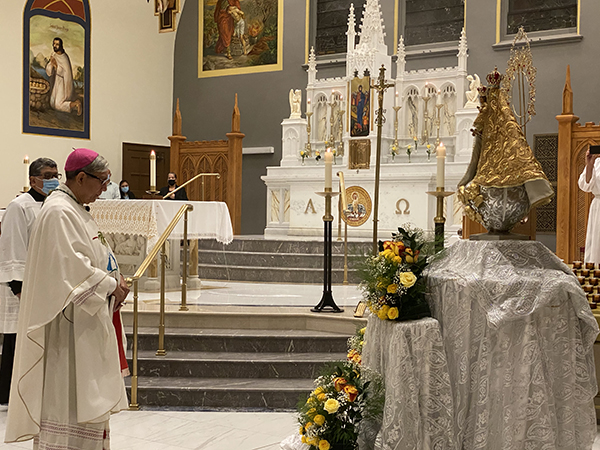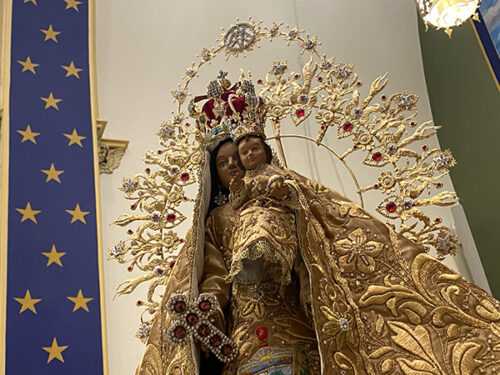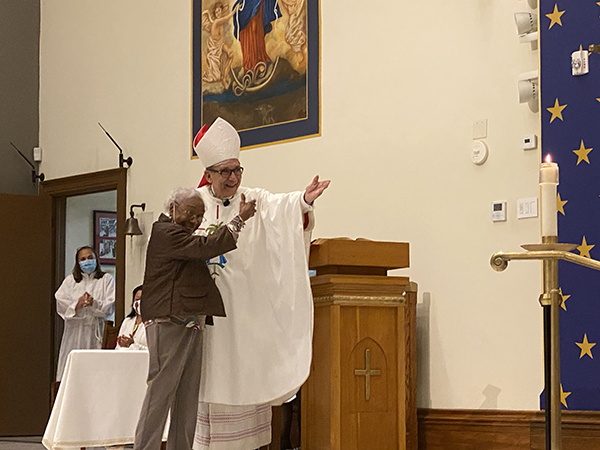
CORONA — “I come from everywhere and I go everywhere. I am art among the arts and with the mountains, I am one.” These verses, from Cuban patriot and poet José Martí, were on the mind of retired Auxiliary Bishop Octavio Cisneros as he prepared to present Our Lady of Sorrows Church with a statue of Our Lady of Charity.
On the morning of Oct. 30, it was announced that Pope Francis had accepted Bishop Cisneros‘ resignation. It was only fitting that on that day, he marked his 49 years in the Brooklyn Diocese by returning to the parish where he was once pastor bearing a gift to honor his home of Cuba and his adoptive home of the diocese.
“The Cuban immigrants came to the diocese of Brooklyn … most of them settled in northern Queens,” many of them with a devotion to the Blessed Mother, he explained.
Each one of those parishes within the diocese had an image of Our Blessed Mother, except for Our Lady of Sorrows in Corona.
“I thought since I was pastor here, of offering to this community — but more than that to northern Queens and indeed to the whole diocese — an image that is very personal to me because it’s mine,” he said.
Bishop Cisneros personally commissioned the statue of Our Lady of Charity, which is a replica of the statue that can be found in the sanctuary of the National Shrine of Our Lady of Charity in the town of El Cobre in Cuba.
Rather than have it sit in his room, Bishop Cisneros chose to offer it to his former parish as a symbol of faith, hope, and the Cuban people of the Brooklyn Diocese. The statue was done by an unknown Cuban exiled artist in Venezuela.

While many have a special connection to the Our Lady of Charity, “our Blessed Mother in Cuba has become so ingrained in the people that to say ‘Caridad del Cobre’ is to say ‘I’m Cuban,’ ” he told The Tablet.
Today, there is less of a Cuban presence at Our Lady of Sorrows than there was in the 1980s when Bishop Cisneros was pastor. “The bakery was Cuban, the barber was Cuban, this whole area was very Cuban,” he recalled.
Now, one of the last bastions of Cuban presence is a close-knit group of longtime parishioners who remember when Bishop Cisneros arrived as pastor, who could be seen seated in the first pew at Mass on Friday night.
When Bishop Cisneros came to the U.S., even as a teenager, Our Lady of Charity had always been there for him. However, it was when he came to Our Lady of Sorrows that Bishop Cisneros’ devotion to her grew in adulthood.
“When I became a priest, these people who were in the first pews are the ones that adopted me, and then I became a devotee of the Blessed Mother,” he explained.

Father Manuel de Jesús Rodríguez, who became the pastor of Our Lady of Sorrows in June, also has a special devotion to Our Lady of Charity. He spent a year of his theological studies in Santiago de Cuba, a short distance from the National Shrine of Our Lady of Charity.
“Ever since I had this experience, I had a personal connection with Our Lady of Charity,” he told The Tablet. “She embodies the soul of this country, of these people,” he said.
While other Latinos coming to the U.S. may have the option or opportunity to return to their homeland, “that’s not the case for the Cubans,” he explained.
“The Cubans are forced out. This tragedy is embraced by Our Lady of Charity because she takes care of the Cubans scattered throughout the world. This is why this devotion, this tradition is so important,” Father Rodríguez said.
Now, Our Lady of Sorrows started a capital campaign to build a 24-hour adoration chapel behind the major altar of the church. The parish has used this year’s Annual Catholic Appeal to raise over $40,000 for the chapel — the perfect home for Our Lady of Charity.
“When Bishop Cisneros mentioned to me that this image was available, I begged him, ‘Give it to us!’ We need it for the chapel,” said Father Rodríguez. The goal is to open the chapel by the beginning of February.
“We cannot forget where we come from,” Bishop Cisneros added, “and we have to understand that wherever immigrants come from, they have brought their faith, they have brought their love for Mary. That’s one of the characteristics that bring us together.”
